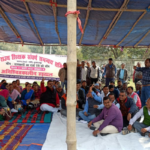Efforts have intensified in recent months to fight two pandemics: the COVID-19 pandemic that threatens lives and the economic pandemic that threatens the livelihoods of millions of workers. Much less attention has been paid to a third pandemic that is lurking in the shadows – increasing violence against women.
A couple of weeks ago, a 42-year-old man in India allegedly murdered his wife, Savithramma, in front of their daughter, in a fit of rage, suspecting her of infidelity. This happened days after the family was quarantined in a temple in Dodderi in Karnataka following the first nationwide lockdown announced by the Indian government to contain the COVID-19 pandemic on March 24, 2020.
No one questions the lockdown. Most people agree that it is necessary. But few recognise the insensitivity and irony behind the government’s appeal to “Stay Home, Stay Safe.” It failed to acknowledge that for many like Savithramma, “safe” and “home” are not synonymous.
The latest data released by the National Commission for Women (NCW) shows a two-fold increase in gender-based violence from 116 (March 2-8) to 257 (March 23-April 1); domestic violence cases are up to from 30 to 69.
Globally too, large numbers of cases continue to be reported in the US, the UK, France, Spain and several other Western nations. In South Africa alone, the first week of the lockdown witnessed 90,000 reports of violence against women. In Malaysia and China, the distress calls have doubled.
Equally misleading is data that points to more men than women suffering because of COVID-19. Drawing attention to only patterns of infection and mortality masks the reality in the lives of women. Hardships suffered by women tend to be many times greater than those faced by men. Ask a simple question and the why of it becomes obvious: who does the “looking after” when someone in a family falls sick?
Also read: The COVID-19 Lockdown Will Ravage Prospects for India’s Female Workforce
Ironically, women’s role as primary caregivers at home puts them at a high risk of contracting the coronavirus. And for those in abusive relationships, a cough or a sneeze could trigger violence. But this double bind is not new. Women being neglected from public discourse that adversely affects them is eerily familiar throughout history.
For many women, staying at home is a public health crisis. India’s National Family Health Survey reveals that close to 42% of men agree that a husband is justified in hitting or beating his wife. It is then not surprising that a third of India’s women have experienced some form of physical, emotional or sexual violence in their lifetime.
Forcing families to stay at home, cooped together in the same small space, increases the risks of interpersonal violence and abuse. Such risks increase as men tend to release their frustration of losing jobs by abusing women in intimate relationships. Admirably, even though women are more likely to lose even the informal sector jobs they had first and faster than men, they do not vent their frustrations by turning violent.
Recession studies also show that victims often turn to their friends and family for temporary housing and emotional support. But given the lockdown and the economic crisis, that support network is not within reach, leaving many battered and homeless.
Staying at home adds to other hardships faced by women. This places a disproportionate burden on women of taking care of the house and children. Living with an abusive partner also puts women’s sexual health agency at risk. The fear of refusing sex or asking one’s partner to use a condom compounds physical and sexual violence between partners and makes it harder for women to access contraceptives, pregnancy kits and abortion services.
Moreover, as the lockdown continues, women and girls will need regular and quality access to menstrual health products. It wasn’t until much public outcry that feminine hygiene products were included in the government’s list of essential items.
Also read: From Abuse to Jobs, the Crisis Will Burden Women More Than Men
Finally, for women in rural areas who have to walk miles to get firewood for cooking and open defecation, sexual violence from non-partners is twice as likely.
Reporting domestic violence even under normal circumstances is difficult. The stigma around domestic violence as a couple’s “private matter” makes it hard for women to leave their abusive partners. For those married into large families, reporting a husband can also mean torture from in-laws.
The situation worsens during a lockdown. For most women, getting access to a phone and calling for help or reporting violence might be a challenge in itself. The deployment of police on the streets makes it even more intimidating for the already-traumatised women.
As we live through the pandemic, a lot of victims won’t make it to the official statistics. In a survey, nearly 75% of those who reported domestic violence did not seek help from anyone. The ones who did relied on other family members and friends, showing that a “pyramid of reporting” exists where domestic violence victims tend to rely on informal networks over seeking institutional or legal help.
The National Commission on Women has flagged the issue of domestic violence during the COVID-19 pandemic, and has been encouraging women to speak out. It is hardly enough.
Also read: South Asian Domestic Violence Survivors in Silicon Valley Grapple With COVID-19 Lockdown
Women’s organisations need to amplify their efforts and publicise helplines. The “red dot” initiative by non-profit WEFT (Women’s Entrepreneurs for Transformation) is one such initiative. Similar to the “mask19” campaign in France and Spain, victims are asked to draw a red dot on their palm to seek help and alert their neighbours and authorities.
State governments must ensure that the 181 helpline services are up and running. Greater social awareness, better and more sensitive policing, improving early access to abortion and pregnancy testing, and providing safe shelters for victims of domestic violence can help deal with the silent epidemic of domestic violence.
As the uncertainty around COVID-19 continues, it’s necessary to acknowledge and make concerted efforts to address this third pandemic that thousands are battling (alone) at home. Else, we may end up magnifying the damage caused by the current public health crisis.
Girija Shivakumar is a Delhi-based journalist.




